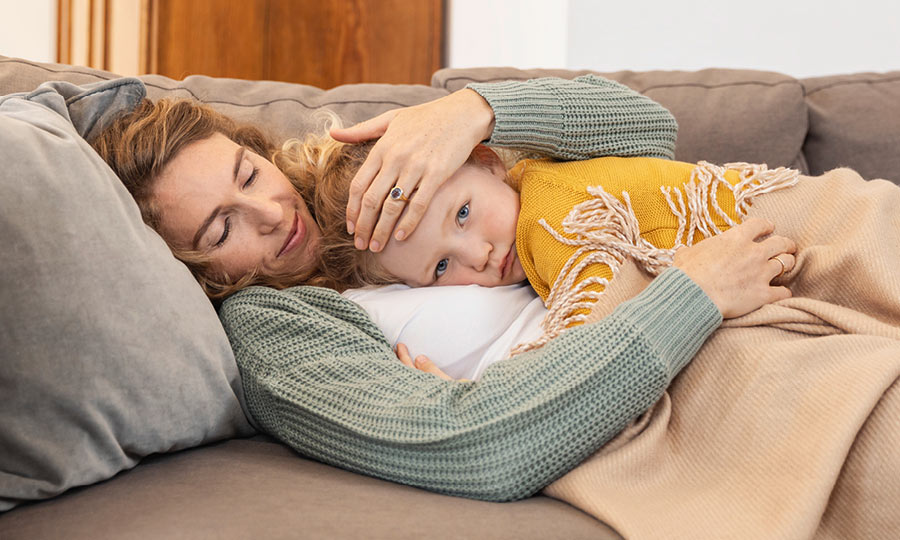Bronchiolitis is a common respiratory disease in infants and children. Find how here about the differences between bronchiolitis and bronchitis, the causes of bronchiolitis and how treatment can help. We also explain if and how you can protect your child.
Bronchitis is an inflammation of the bronchi. With bronchiolitis, the bronchioles are inflamed. To understand the difference between the bronchi and the bronchioles, it is best to imagine the lungs as an upside-down tree. The tree trunk is the windpipe (trachea), the branches are the bronchi branching out from the trunk, and the even finer twigs are the bronchioles. Find out more about the bronchi and lungs here. Bronchitis and bronchiolitis are both obstructive respiratory diseases. While bronchiolitis is especially prevalent in infants and toddlers up to the age of 24 months, bronchitis affects children and adults.

In most cases, bronchiolitis is caused by viruses. The most common viral trigger is respiratory syncytial virus (RSV). This is why the term RSV bronchiolitis is often used. Aside from RSV, common rhinoviruses and parainfluenza viruses can also trigger bronchiolitis1.
As bronchiolitis usually starts as a respiratory infection of the upper airways, bronchiolitis in children starts with the same symptoms as a common cold:
Bronchiolitis does not develop from the infection until the pathogen moves down from the upper to the lower airways and triggers inflammation of the bronchioles. Symptoms are then often:
NB: If your child has these symptoms, they should always see a doctor.
While bronchitis can become chronic, bronchiolitis is always acute. Generally, bronchiolitis resolves after 14 days. However, in some children, a hypersensitive bronchial system and cough can remain a little longer as residual symptoms. About 10% of children with acute bronchiolitis still have a cough after 3 weeks1. Adequate treatment is, however, important, as a persistently hypersensitive bronchial system can lead to bronchial asthma.
It is a good idea to treat the symptoms. Inhalation with saline solution is especially effective against the cough and mucus build-up. Always discuss the treatment of bronchiolitis with your paediatrician. Rest and plenty of fluids are also very important. If your baby refuses to drink, visit your paediatrician without delay.
Inhaling with a suitable inhalation device is a tried-and-tested method to treat a cough. Inhaling with hypertonic saline solution is a treatment with a well-earned foothold in paediatric and adolescent medicine for the treatment of bronchiolitis. Isotonic inhalation solution should be inhaled for a dry cough and a hypersensitive bronchial system.
Inhalation therapy with hypertonic saline solution can liquefy the mucus, make it easier to cough up and so better transport it out of the bronchioles. Your child may experience a stronger urge to cough during and after inhalation with hypertonic saline solution. This is generally a sign that it is now easier to shift the mucus.
As bronchiolitis most commonly affects babies and toddlers under the age of 2 years, the most suitable inhalation device is the PARI BOY Junior:

PARI BOY Junior
With a variable droplet spectrum, designed for treating babies and toddlers.
The most common trigger for bronchiolitis – viral infections of the airways – are difficult to avoid. However, there are some things you can do to protect your child from bronchiolitis:
The most common trigger of bronchiolitis is RSV. An infection is usually difficult to avoid. You can make sure that your child inhales isotonic saline solution at the first signs of a cold. If your child still develops symptoms of bronchiolitis, such as shortness of breath or a severe cough with sputum, please visit the paediatrician. Inhalation with hypertonic saline solution is an effective treatment for a build-up of mucus in patients with bronchiolitis.
References
[1] Schorlemer C, Eber E. Akute virale Bronchiolitis und obstruktive Bronchitis bei Kindern. Monatsschr Kinderheilkd. 2020;168(12):1147-1157.
Contact us
Any questions? You can reach our service center at this number:
+49 8151 279-5220
© 2025 PARI GmbH Spezialisten für effektive Inhalation